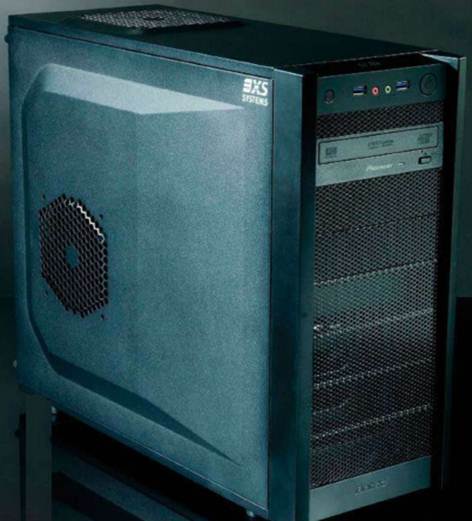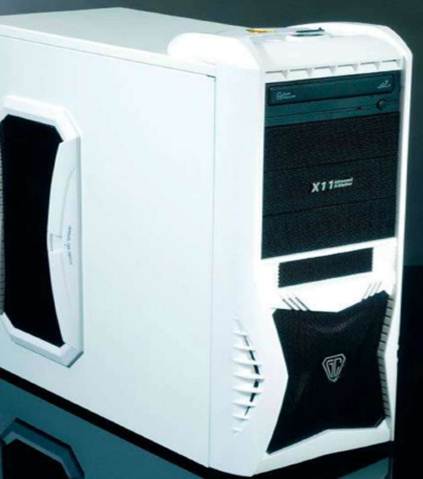Super test: Scan 3XS Z77 Performance GTK3

When you’re putting together a machine for
a thousand of your Earth pounds, there are many options to consider and many
different configurations. We don’t have any identikit builds in this test,
though there are threads that run throughout, like the use of Intel CPUs.
Balance is important, but the chances are you’re going to have to make a
compromise or a sacrifice somewhere.
Like the Cyberpower machine, you can
plainly see where the sacrifices have been made in this rig before even looking
at the benchmarks. We are, of course, talking about the decision to opt for a
GTX 660 Ti in the graphics card slot. Where it differs from the Cyberpower is
that we’ve got a lot more in return for giving up some straight-line graphics
performance. That 240GB SSD is a real bonus, and something we’d be pleased to
find in any rig.
With 240GB of space on your OS boot drive,
you can fit in a healthy Stream collection, and it will all boot and respond
just as you’d expect from a solid state starting point.
That ubiquitous Intel CPU is once again
given the 4.6GHz treatment, and comes with an absolutely mammoth air-cooler
strapped to it to keep it running happily with its chunky clock speed. The
Gigabyte Z77X-D3H is one of the two mobos of choice in this test – the other
being Asus’ similarly budget-oriented P8Z77-VLX – and both are excellent value
choices for an all-round PC build.
The difficulty is that we’re going to keep
coming back to that GPU choice. Performance is (almost) everything, and when a
rig is giving gaming benchmark numbers this far off the pace, it becomes tough
to recommend. This 3XS machine leaves you with a stark decision to make: is the
chunky SSD worth the relative lack of gaming prowess? For us PC gamers, the
answer has to be no.
Easy
upgrade
The SSD may make your games and PC boot
quickly, but by the time you’re in-game, mowing down zomboids from a Huey or
engaging in massive skirmishes planeside, it’s all about frame rates.
You don’t want to be thinking about
upgrades straight away when you’ve just spent $1.5K on a gaming PC, but
dropping in an SSD later is going to be a cheaper upgrade path than throwing
away your GTX 660 Ti and buying a new, faster graphics card. From a starting
point then we’d much rather have a speedier GPU and a HDD, or a low-capacity
SSD that we can upgrade at a later date.
Specs are only part of the build though –
almost as important is the service you get. Sure, if everything works perfectly
for three years you’ll have no need of SI back up, but that’s a situation that
rarely happens. Scan has easily the best standard warranty of all the SIs in
the test. If it was just a three-year parts and labour warranty it would be
great, but when the first year is on-site, it takes it to another level. While
we wouldn’t necessarily recommend this spec for a $1.5k build because of the
focus on SSD rather than GPU, we would have no hesitation recommending Scan
build you a rig of your choosing.
|
Vital statistics
|
|
|
Price:
|
$1,500
|
|
Manufacturer:
|
Scan
|
|
Web:
|
www.scan.co.uk
|
|
CPU:
|
Intel Core i5-3570K @4.6GHz
|
|
Motherboard:
|
Gigabyte Z77X-D3H
|
|
Memory:
|
8GB Corsair Vengeance
|
|
Graphics:
|
EVGA GTX 660 Ti
|
|
SSD:
|
240GB Corsair Force 3
|
|
HDD:
|
1TB Seagate
|
|
PCFormat Verdict
|
4/5
|
|
Features:
|
4.5/5
|
|
Performance:
|
3.5/5
|
|
Value:
|
4/5
|
|
We may not agree with the specs list, but
you can’t argue with the way its put together or the level of service.
|
Super test: Vibox Boss XS

Attention all you pigeons out there, let me
introduce to you the PC-shaped cat from relative system integrator n00b Vibox.
There are two rigs in this group test that have thrown all their eggs in the gaming
performance basket: this Boss XS and the YOYOTech machine. The top-end pairing
of the Core i7-3770K and the Nvidia GTX 680 make this an incredibly formidable
gaming PC.
Starting with the overclocked Core i7 CPU,
you have essentially the finest example of Intel’s desktop processor pedigree.
With eight full Hyperthreaded threads of processing power, it puts the
quad-core i5 to shame in any straight-line CPU test. In the Cinebench and X264
encoding tests, the Hyperthreaded i7 in the Vibox machine is over 20 per cent
faster than the quickest overclocked i5 rig.
If you’re looking at any productivity apps,
most of them will benefit from this extra processing power. Video and photo
editing will both take the extra threads on offer and use them to their fullest.
Lighting
fast
But this is a gaming PPC first and
foremost, right? Most game engines don’t really benefit a whole heap from a
processor with extra threads, and while that may change going forward, this i7
is not really going to translate into faster frame rates in-game.
Vibox still has you covered though, as it’s
included Nvidia’s faster ever gaming graphics card, the Kepler-powered GTX 680.
It’s a lighting fast GPU that will chew through all but the most
compute-focused game engines. The Boss XS houses a stock-clocked card, and
while that means in a lot of the gaming benchmarks, it’s not a whole lot faster
than a GTX 670 – especially the overclocked cards – it has a little more to
offer itself.
The issue is that after spending a grand on
a rig, you don’t want to start messing around with clock speeds and risk
borking both your card and your warranty. So, was it really worth Vibox
Dropping in the GTX 680 instead of a GTX 670? Saving a little extra cash by
option for the marginally slower GPU would have meant it could add a small SSD
as a Smart Response caching drive or simple boot drive.
As it is, Vibox has chosen a straight hard
drive as the only storage option in the rig. As we alluded to when we discussed
the Scan rig and its chunky SSD, once you’re in-game you’d be hard pushed to
notice the difference when you’ve got speedy frame rates. Where the Boss XS
falls over is that it hasn’t gone for a SATA 6Gbps HSS. Instead, Vibox has
dropped a snail-paced SATA 3Gbps drive in the system.
With a 40-second boot time, and very
noticeable speed difference in game boots and navigation, this may well be a
cut too far. The CPU may give it the win in processing terms, but the
overclocked HD 7970 wins the gaming battle and the slow hard drive does make
for a rather sluggish-feeling rig.
Of less concern is the fugly chassis. When
it’s hidden under the desk I don’t care what my rig looks like, and dropping in
a cheap SSD later on would give a whole different outlook to this machine. On
balance, the Boss XS is just a little too skewed in one direction.
|
Vital statistics
|
|
Price:
|
$1,500
|
|
Manufacturer:
|
Vibox
|
|
Web:
|
www.vibox.co.uk
|
|
CPU:
|
Intel Core i7-3770K @4.5GHz
|
|
Motherboard:
|
Gigabyte Z77X-D3H
|
|
Memory:
|
8GB Corsair Vengeance
|
|
Graphics:
|
Nvidia GTX 680
|
|
SSD:
|
None
|
|
HDD:
|
1TB Seagate SATA 3Gbps
|
|
PCFormat Verdict
|
4/5
|
|
Features:
|
3.5/5
|
|
Performance:
|
4.5/5
|
|
Value:
|
4/5
|
|
The chassis is ugly, there’s no SSD and
the hard drive is slow, but in-game the performance is there in spades.
|